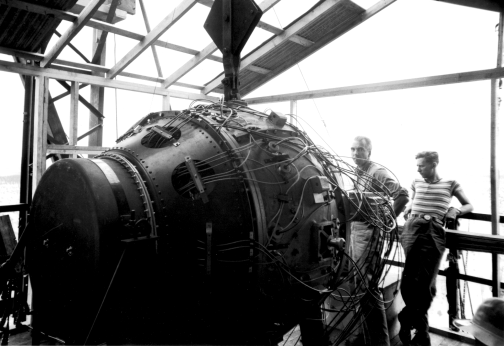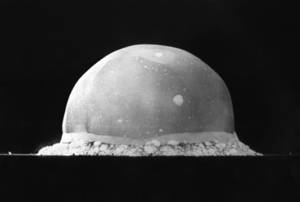Trinity - The site of the first Atomic Bomb Test
Interview with
Sarah - Now, on the 16th of July 1945, the project code name Trinity was put into action. Trinity was the first test of an atomic bomb, the first nuclear weapon. The bomb, nicknamed the Gadget, was detonated in a remote area of New Mexico and the test heralded the birth of the atomic age with the "fat man" atomic bomb being detonated over Nagasaki in Japan, less than a month later. Sixty five years on, the test site is hard to access and rarely visited, but journalist and author David Wolman risked the radiation to find out more about this historic site. Hi, David.
David - Hi there, Sarah.
Sarah - Welcome to the Naked Scientists.
David - Thank you.
Sarah - Why don't you start off by setting the scene for us a bit. Where exactly is the Trinity site and what's it like?
 David - Sure. Well in the Southern part of the already rather desolate state of New Mexico, there is this giant swatch of land that the military owns. Today, it's called White Sands Missile Range and one spot within that area is a of sort desert basin and blaring sunshine, and creosote and sage brush, and mesquite. You have this black obelisk now standing to mark the spot at ground zero where the first atomic bomb was detonated. And at that time, almost everyone in America didn't know what was happening down there and it was chosen not surprisingly because it is so incredibly remote. There were some people around there who needed to be evacuated and no-one lives there now, but it is safe to visit, and for the past 30 or 40 years or so, twice a year, I think it's the first Saturday in October and in April, the public is allowed to visit the Trinity site.
David - Sure. Well in the Southern part of the already rather desolate state of New Mexico, there is this giant swatch of land that the military owns. Today, it's called White Sands Missile Range and one spot within that area is a of sort desert basin and blaring sunshine, and creosote and sage brush, and mesquite. You have this black obelisk now standing to mark the spot at ground zero where the first atomic bomb was detonated. And at that time, almost everyone in America didn't know what was happening down there and it was chosen not surprisingly because it is so incredibly remote. There were some people around there who needed to be evacuated and no-one lives there now, but it is safe to visit, and for the past 30 or 40 years or so, twice a year, I think it's the first Saturday in October and in April, the public is allowed to visit the Trinity site.
Sarah - What's it like when people go to visit there? I mean, what sort of thing do people expect to see when they come?
David - Well, another journalist and I joined a caravan of cars leaving from the nearby town of Alamogordo. Because it's in a currently active missile range or military installation, you're not really allowed to colour outside the lines when you visit Trinity and so, you meet up with this caravan, have a brief security check, sort of like going to the airport and then we drove about an hour into the dessert. And when you finally get there, there's sort of a large gravel parking lot with a lot of people, a lot of SUVs it seems from Texas, and there are a couple of stands selling hotdogs and people selling books about atomic history, and then you walk down a corridor that's marked off by a chain link fence with some barbed wire on the top. And there are signs on it that say, 'Caution, radioactive active materials' beyond the fence, but the radar activity there is not a health hazard, I should say that right off the bat because I probably wouldn't have gone if it is!
Anyway, you walk down this long corridor through the dessert. It's very dusty and sunny, so sunny. And then you finally get to a large enclosed area, still with the fencing, and that's where the obelisk sits and people are wandering around, sort of kicking their shoes in the dirt and in the dust because of course, there's a sign that says, please don't handle the Trinitite which is this glassy residue that is this light greenish colour rock that exists in the area that was created by the blast. And of course, there's a sign that says, "Trinitite is government property. Please don't pick it up and handle it." And so, that immediately makes everybody want to look for the stuff. And in fact, it's all over the place. I took a picture with some in my hand, but I figured as a journalist, I better not take any out of there, at least not right about it because that would be trouble.
Sarah - Well, it's this first thing people do, isn't it? You tell them not to do something and they go and do it.
David - Exactly.
Sarah - When you visit - when you look at it, would you know that it was the site of the test at that or is it actually, you know, surprisingly biodiverse or is it very obvious that some huge explosion happened there?

David - It's really not obvious. I think in the 60s, they bulldozed a lot of the residue and the glass that was created. And so now, you have a lot of this kind of sage brush desert landscape. It's a little more mountainous in the distance than I had imagined. Being from New England myself, I had always pictured it as flat as a pancake, as far as you can see, and in fact, it's sort of this basin area tucked between two mountain ranges. But you really wouldn't know from a distance and of course, there's this 8 or 10 foot tall stone obelisk there and a little monument, but you know, I was a little surprised not to see anything, for example, commemorating the war dead. This is certainly a science pilgrimage. It's not a war memorial. You know, the people there are wearing t-shirts with a periodic table on them, but still, it's a little strange that the tenor of the thing with the hotdog stands and nothing about dead people which is maybe an editorial for someone else to write, but a lot of people there are just snapping pictures, and are really excited to be in the centre of where this great scientific achievement happened regardless of your politics. And so that part is really interesting to me, but from a distance, you would never, ever know and in fact, you know, what brought me to Trinity and also to some other spots around the west this spring was this project I was working on called Accidental Wilderness because this area around Trinity, the White Sands Missile Range is still off limits to the public.
For the past 60 years, you have this flourishing ecosystem there because there are no people. There's no roads, there's no houses, there's very little public disturbance. And so, that is really an interesting irony and the same story can be told for a dozen places across the American west where the military has set out this great boundary and says nobody really can come inside here except maybe some wildlife biologists now and then. And the result is some of the most vibrant ecosystems and biodiversity rich areas left really on the continent.
Sarah - Well that's very exciting. So out of something quite violent can come a good story for biodiversity. Thanks so much, David. That was David Wolman and you can find more of his articles on his website at david-wolman.com.
References
- Previous The Super X Divertor
- Next Cremation in the Bronze Age










Comments
Add a comment